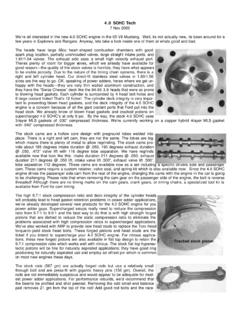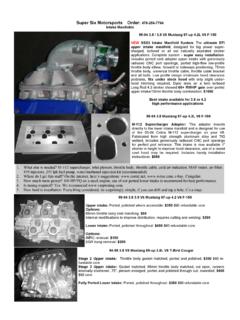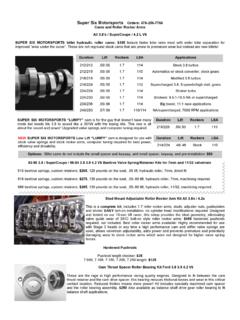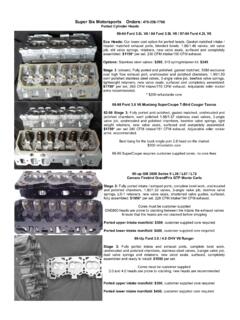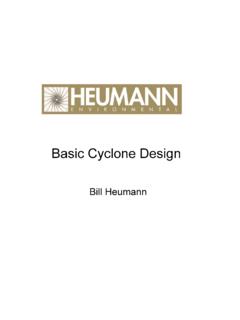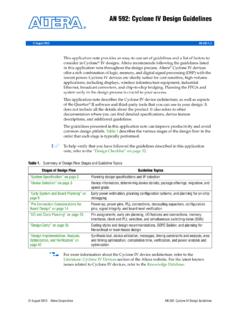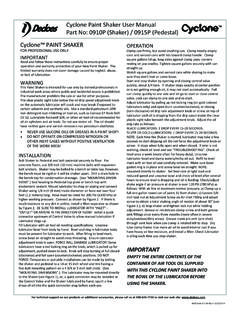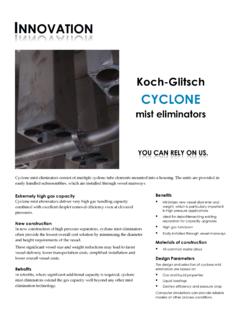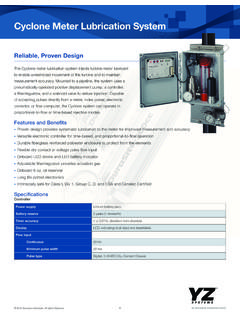Transcription of Cyclone 3.5L EcoBoost, 3.5 Duratech and 3.7L Ti-VCT V6 ...
1 Cyclone EcoBoost, Duratech and Ti-VCT V6 Engine Tech All 3 variants use the same forged crankshaft with stroke. The difference is the bore, for the and for the version. The blocks are cast aluminum with floating cylinder walls and cast iron liners. They ap-pear to use the same block but we have not confirmed this yet. We re interested to learn if the blocks use the same bell-housing pattern or are interchangeable between FWD, AWD and RWD applications. That was not the case with the which used different FWD and RWD versions with the main difference being the bellhousing bolt patterns. Seems that just about all of the parts now use a QR symbol. All use the same powder metal connecting rod which includes a bushing on the pin end for a floating pin.
2 The rod is shot peened for improved fatigue strength, has a decent cross-section and uses cap screws instead of through bolts. The rod shown on the left is a 96-04 powder metal rod, the Cyclone rod in the center and one of our favorite 351W forged I-beam rods on the right. Notice how the cross section of the Cyclone rod appears to be more like the 351W I-beam than the rod which was much to weak for high perfor-mance applications. Only time, boost and nitrous will determine the durability and strength of the Cyclone rod, but since the EcoBoost engine has already been proven to provide exceptional durability in the 365-400 HP range with Ford s factory tuning expertise, we can expect adequate durability at power levels around 500 HP or so with upper rev limits at 6500-7000 or so as long as the tuning is on the money without detonation.
3 The Cyclone rod is no light weight at over 630 grams, but at least most of that is in the big end where the rod could be lightened without weakening it. The small end of the rod is actually tapered which reduces the important weight up at the top of the cylinder, but the pin is thick walled and very heavy. Compression ratios are 11:1 for the EcoBoost and :1 for the 11:1 compression ratio for a turbo application is an exceptional accomplishment owed to unique technologies that are employed in Eco-Boost which include unique piston crown details, direct fuel injection into the combustion chamber instead of the intake port, variable valve timing of both intake and exhaust cams and internal piston cooling.
4 EcoBoost uses a unique cam driven mechanical fuel pump to raise the fuel pressure from 40 PSI to ~ 2200 PSI for direct injection. This high pressure mechanical pump is driv-en by a special lobe on the intake cam on the driver side cylinder head. The generic use cast iron cams, that visually appear to be identical with exception of the lobe locations, and have identical engineering numbers. The is a tiny lasered part number below the QR symbol that may differentiate the intake and exhaust cams. EcoBoost uses what appears to be a billet steel intake cam with the special lobe. We ve already seen one generic cam broken in two, so perhaps the EcoBoost billet cam was intended to add some strength due to the mechanical fuel pump.
5 The pistons of the EcoBoost and the generic are both hypereutectic and use anti-friction coated piston skirts, this has become the norm for modern production engines. The pistons are made with internal lightening pockets to reduce reciprocating weight and use modern thin, high performance rings with a Dykes-style 2nd ring. The pistons are light weight at 372 grams but the wrist pins are thick walled and pretty heavy at 119 grams. The EcoBoost piston combines a dome with dual intake valve reliefs and an internal dish, kinda looks like a toilet bowl seat, where the bowl is the target of the direct injection. The piston uses a shallow flat topped domed design with 4 valve reliefs.
6 We ll have to wait and see how well the stock pistons hold up once the hot rodding begins with increased boost, superchargers, nitrous, etc but as we know, hypereutectic pistons in general don t tolerate even the smallest amount of tuning error, detonation, etc without catastrophic failure. The cylinder heads are paired, there are specific left hand and right cylinder heads that cannot be interchanged. The heads are clearly marked in several locations and even include alloy identification markings! The intake port volume is 194cc, the exhaust port is 83cc and the combus-tion chamber is 59cc. The and do not use the same cylinder heads and the heads do not interchange.
7 The Eco-Boost cylinder head is also different from the generic and cylinder heads with regards to direct injection and the exhaust flange bolt pat-terns The combustion cham-ber is shaped differently and of course the presence of the hole for the fuel injector. In that regard, EcoBoost fuel injectors are located below the intake ports. Each head uses a master cam cap which holds the electronic controllers which vary intake and exhaust cam position via oil pressure. The cam phasers are mounted on the front end of each cam with a single bolt (conventionally threaded by the way) that is tightened to a torque value that would make even King Kong envious. The cam phasers are also indexed to the cam with a small pin.
8 Plenty of leverage is needed here and thankfully the cams have wrenching surfaces in several places. The cams rotate in the clockwise direction on both heads. The timing chain directly drives the intake cam on each head and the exhaust cams are driven indirectly from the intake cams by secondary chains which each have their own hydraulic tensioners. Each of the minor intake and exhaust cam caps are identified by number and direction, but there is no con-vention which identifies them by head, this has several connotations, so until it is determined what the tolerances are, plan to segregate cam caps by cylinder head. The master cap represents #1 and #5, #2-4 on the exhaust side from front to back, and #6-8 on the intake side from front to back.
9 Like most modern engines, MLS head gaskets are used, 4-layer construction, .050 thick. As might be expected, the exhaust manifolds are different as well and the EcoBoost exhaust manifolds do not fit on the heads due to the differing bolt patterns. Unlike the valvetrain of the new Coyote engine which uses hydraulic lash adjusters and cam followers, the valvetrain of the generic and EcoBoost uses what Ford calls Direct Actuating Mechanical Buckets . This type of system has been used on motorcycles for ages and other automotive applications such as Toyota 2JZ-GTE after being pioneered by Cosworth many years ago. You can liken this to a pushrod engine comparison as the difference between a hydraulic lifter and a solid lifter.
10 Just like a solid lifter valvetrain operates with a certain amount of lash or clearance, so does di-rect actuation operate with lash or clearance between the cam lobe and the upper surface of the bucket. Without the hy-draulics of a lash adjuster and without the weight of the follower, the Cyclone valvetrain should exhibit better high RPM stability than the Coyote ! The lobe contact surface of the bucket is highly polished and appears to be very slightly crowned like a conventional solid lifter. The buckets are computer matched at time of assembly, probably as a means to accept very minor tolerances on the depth of the valve job because the lash values, cam to bucket clearances, are very tight.
